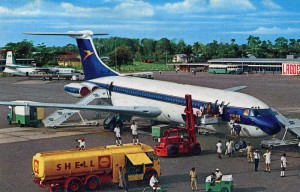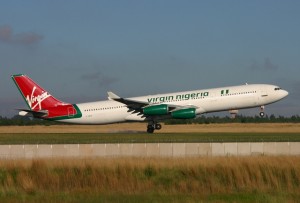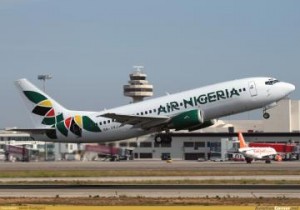 When I was a child, in the late 1960s, I lived in Ibadan, Nigeria. From Ibadan we once flew to the then capital Lagos on a Nigerian Airways WAAC flight –along with live chickens in the cabin. (Pictured is a the type of Vickers plane they used at Lagos Airport in 1969 -Wikipedia)
When I was a child, in the late 1960s, I lived in Ibadan, Nigeria. From Ibadan we once flew to the then capital Lagos on a Nigerian Airways WAAC flight –along with live chickens in the cabin. (Pictured is a the type of Vickers plane they used at Lagos Airport in 1969 -Wikipedia)
The carrier was renamed Nigeria Airways in 1971, the year I left Nigeria. Sadly, despite government ownership, the great BOAC legacy and a potentially huge passenger base, Nigeria Airways folded in 2004.
The Nigerian government immediately began negotiations for a new carrier and Virgin Nigeria Airways was born on 28 June 2005. Unlike Nigeria Airways, this new carrier was privately owned: 40 per cent by Virgin Atlantic Airways (who licensed the Virgin brand name) and 51 per cent by Nigerian institutional investors.
The Virgin name brought credibility to a carrier that focussed on safety, service and profitability. They operated domestic, regional and international flights from their Lagos Airport base. The formula worked and Nigerians liked the airline. It grew rapidly carrying its one millionth passenger by 2007.
In 2008, Virgin Atlantic stated that it planned to sell its stake in the carrier and allow it to stand alone as a wholly Nigerian-owned venture. The carrier shifted its focus, suspending its long haul international flights. In 2009, ahead of its divesture, Virgin Atlantic withdrew permission to use the Virgin name and the carrier rebranded to Nigeria Eagle Airlines. Barely 10 months later, the airline became Air Nigeria. Its slogan was “Passionately Connecting Africa” Air Nigeria
Once seen as the saviour of the Nigerian air industry, the airline struggled after Virgin sold its 49% share.
In January 2012, Licensed Engineers in Air Nigeria went on strike because they claimed they were being forced to certify unfit aircraft into the air. In May, the company was showing signs of severe financial distress. In June, 2012 a former top company official referred to the airline’s as “flying coffins” because maintenance had been so severely cut. He warned Nigerians not to fly the carrier. There were claims the airlines was siphoning off funds to pay for their owner’s other investments. Soon companies began withdrawing services to Air Nigeria for non payment of accounts. On 6 September 2012 Air Nigeria announced that the management had sacked almost all of its employees for “dishonesty” and that the airline was ceasing all services four days later. The Nigerian regulators noted the carrier owed $US30 million in tax claims dating back to 2007. In addition, employees had not been paid for four months when they lost their jobs.
Air Nigeria ceased operations on September 10, 2012 laying off 800 employees. Passengers on a London to Lagos flight were even asked to pay 40 pounds each to buy enough fuel for the flight home! The Chair of the carrier said it was “difficult to continue further investment in the carrier with the high level of members of staff disloyalty and weak business environment.”The claim is that investors behind the airline have struggled to deal with $250m (£157m) of debt taken on when they bought the carrier from Virgin two years ago. The airline’s Management have vowed to fly again within a year but staff pointed out that they were owed four month of wages.
At the same time, Arik Air Nigeria (now the country’s largest carrier) suspended services over a dispute with the country’s safety authority. And a third carrier Dana Air got back its operating licence suspended in June, 2012 following a crash of one its planes which resulted in at least 150 deaths but faces a very untrusting public.
So Nigeria is essentially now without a trusted local carrier. Worse, Air Nigeria are the latest in a long line of carriers that have vanished. Yet Nigeria has 18 per cent of Africa’s population and 65 per cent of all the air traffic in West Africa. It should have a thriving market. Yet Ghana, Ethiopia and Kenya seem to be where the future of African air travel is.
The collapse of Air Nigeria could be filled in one of four ways:
- A new Nigerian carrier- although this option requires investors, government officials and passengers to be convinced that this time the carrier will succeed
- An enforced merger of all the remaning airlines in Nigeria
- South African Airways could provide an extensive network of flights between African countries and between Nigeria and the UK. SAA recently ended their London to Cape Town in August, 2012 and announced they plan to expand capacity to the healthy west African markets of Ivory Coast, Gahna and Nigeria as well as India and Australia.
- An existing or new Ghanian carrier could expand into Nigeria, taking on Nigerian domestic and international flights. There are three possibilities. One is Ghanian domestic carrier CTK – CiTylinK, which EgyptAir has signed an MoU with. EgyptAir has also proposed acquiring around 50% of the carrier. Another could be the Hainan Airlines owned new start up carrier Africa World Airlines. Or Stelios Haji-Ioannou, the former Chairman of Easy Jet is opening a Ghanian low-cost carrier called Fastjet
Related Posts:






It is not an amazing country.